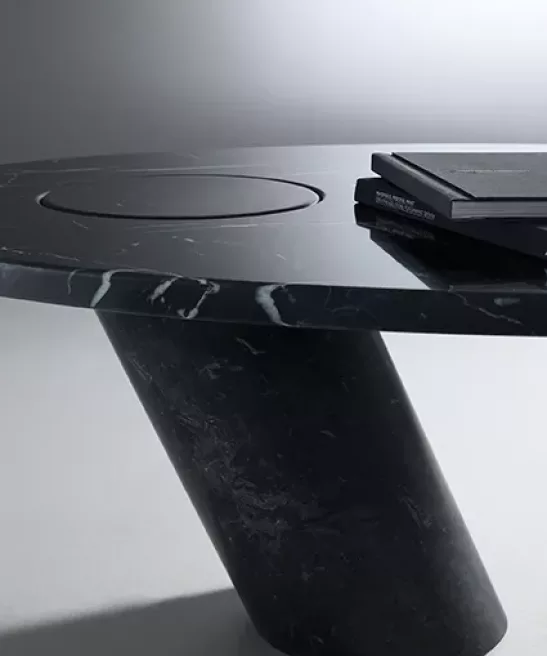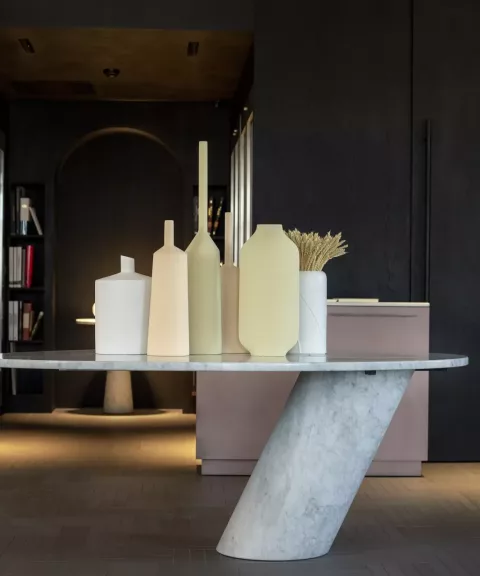Angelo Mangiarotti
He studied at the School of Architecture and at the Polytechnic University of Milan. In 1953, he left for the United States and more precisely for Chicago, where he taught at the Illinois Institute of Technology. He met Ludwig Mies van der Rohe, Frank Lloyd Wright, Walter Gropius and Konrad Wachsmann. On his return to Italy, he founded an architectural firm with Bruno Morassutti and demonstrated the same originality for his buildings, for which he perfected new “construction systems”, as for the assembly of his furniture. See the Mater Misencordiae Church in Milan, a revolutionary architecture for the time (1956), of concrete and metal, surmounted by a glass shell, restored in 2016.
Throughout his career, Mangiarotti has given an important role to plastic research. He worked for major brands like Cassina. Mangiarotti was a very prolific designer to whom we owe many design icons such as the “Lesbo” lamp (1967), the “Saffo” lamp (1967), the “Eros” table (1971), the “Spirale” pendant (1974) and the “Skipper” table (1980).
His personality, his work and his creations have made him a remarkable figure in Italian design. He successfully applied his unique talent to projects of different scales, ranging from architecture to design and, although a proponent of rigorous functionalism, he never neglected the pursuit of elegance and beauty in his work.
He broke through conventional boundaries and ventured into sculpture with his skilful reflections on plasticity and form, always using contemporary materials and manufacturing processes.
His approach and the principles on which it is based have always been the result of a deep awareness of the importance of values with an ethical dimension and he has created his own happiness thanks to the “correctness” of his practice, skilfully managing to reconcile this inescapable dualism of ethics and aesthetics.
Many of Mangiarotti’s works are inspired by two movements:
- The first is the architectural style of ancient Greece, which is found in the shape of objects. Thus, he liked to give a Greek name to his works, such as “Eros”.
- The second is the system of manufacturing and composition of the “Minka” (the old Japanese house), which was assembled without using nails or screws.


It is now the House of Agape, under the Agapecasa brand, which holds the rights to reissue the furniture designed by Angelo Mangiarotti.
Indeed, Agape, an Italian brand specialising in the world of high-end bathrooms, is extending its field of action to offer poetry and sensitivity to the entire universe of the home and has worked to offer an informed public its new brand, Agapecasa, which extends the proposals to all rooms of the house.
Agapecasa thus presents the “Mangiarotti Collection”: a collection made up of exceptional furniture chosen from the repertoire of designer Angelo Mangiarotti, who marked several generations with his creations of excellence, and designed using his original designs and models. All the pieces in the “Mangiarotti” collection are made with beautifully crafted natural materials such as solid wood species, high-end leathers or even luxurious marbles: white Carrara, black Marquinia, grey Carnic, green Alpi and the dark Emperador.
The projects carried out by the Maestro from the beginning of the fifties were carefully analysed from a technical and constructive point of view by the Agapecasa teams, then checked and reinterpreted to meet the changing needs of our time and adapted to current quality and resistance standards and safety requirements.
The “Angelo Mangiarotti” collection consists of 13 projects made with care following the designs of Angelo Mangiarotti, based on the reliefs and the study of the original models. It faithfully reproduces some of the designer’s most famous projects, taking into account the need for a more contemporary production, and introducing small variations in the workmanship but carefully preserving the theoretical, compositional and formal aspects of one of the great artists of the twentieth century.
Among the emblematic pieces, we are struck by the ingenuity of the Cavalletto modular bookcase, designed in the mid-1950s, born of an inverted V-shaped trestle element which can be stacked at will. This system, patented more than half a century ago, makes it possible to manufacture interlocking solid wood furniture without joints or fasteners, of a rare elegance. The same intelligence is at work with the Eros tables, born in the 1970s, from embedding a conical leg in a marble top, the whole thing joined solely by the force of gravity.
The base is flush with the heart of the top, so that it is adjusted to the nearest millimetre by hand.
We find, in his work, formal obsessions, such as the idea of a basin mounted on a column, from the Eros table to the marble washbasins.
Skilful Reflections
The Skilful Reflections exhibition, presented in association with Agapecasa in September 2018, displayed the emblematic pieces of the collection of the Italian architect, supplied in marbles and precious woods. Under the artistic direction of Camilla Benedini, they were beautifully staged, with particular thanks to the use of large mirrors reflecting the sculptural side and the beauty of the furniture which included, among others, the Eros marble tables with conical trunk legs recessed into the top, or even the Eccentrico elliptical tables with a base and a top holding on as if in balance. A time line presented the creations of the Italian Master chronologically, accompanied by photos of projects and sketches, in his 3 fields of expression: architecture, sculpture and furniture.
“This exhibition, unique in France, celebrates the designer’s sought-after and controlled approach to materials, and testifies to his talent in the manipulation of traditional and noble materials at the same time. Creations in which the constant is the search for gravity and the balance of structures”, concludes RBC Paris.
